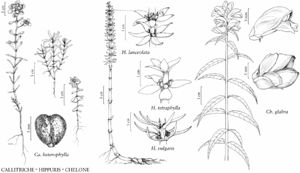Hippuris vulgaris
Sp. Pl. 1: 4. 1753.
Stems 100–400 mm. Rhizomes (2–) 3–5 mm diam. Leaves on mid portions of emergent shoots in whorls of (7 or) 8 or 9 (–12), linear to narrowly oblong or lanceolate, 3–35 × 0.5–2.5 mm, midvein inconspicuous, lateral-veins present, sometimes obscure, ape× subacute to acute or attenuate, tip often curled in dried plants. Flowers bisexual; filaments longer than anthers. Drupes 1.5–2 × 0.8–1 mm. 2n = 32.
Phenology: Flowering summer.
Habitat: Shallow freshwater pools, pond margins.
Elevation: 0–2900 m.
Distribution
St. Pierre and Miquelon, Alta., B.C., Man., N.B., Nfld. and Labr., N.W.T., N.S., Nunavut, Ont., P.E.I., Que., Sask., Yukon, Alaska, Ariz., Calif., Colo., Ill., Ind., Maine, Mass., Mich., Minn., Mont., Nebr., Nev., N.H., N.Mex., N.Y., N.Dak., Oreg., S.Dak., Utah, Vt., Wash., Wis., Wyo., s South America, Eurasia, in Australia
Discussion
Hippuris vulgaris is the most common and widespread species of Hippuris; it is largely absent from the Canadian Arctic Archipelago and Greenland. All specimens seen by the authors from that region are H. lanceolata.
The distribution of Hippuris vulgaris is bipolar, occurring also in southern South America (Patagonia: Argentina and Chile) and Australia; it exists in some areas as a naturalized introduction, possibly from being used in aquaria and ornamental pools. In Australia, H. vulgaris is monitored for its potential to become noxious by spreading rapidly in shallow waterways.
Selected References
None.
